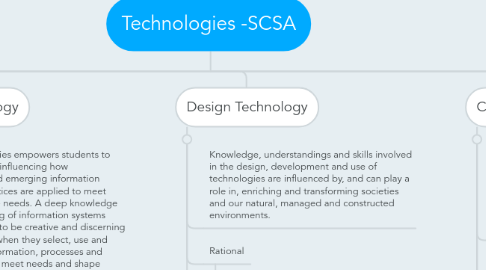
1. Technology
1.1. Technologies enrich and impact on the lives of people and societies globally. Society needs enterprising students who can make discerning decisions about the development and use of technologies, develop solutions to complex challenges and contribute to sustainable patterns of living. Technologies can play an important role in transforming, restoring and sustaining societies and natural, managed and constructed environments. (SCSA, 2017 )
1.1.1. Employee
1.1.2. Employee
1.2. WA Curriculum
1.2.1. Technologies describes two distinct but related subjects: Design and Technologies, in which students use design thinking and technologies to generate and produce solutions for authentic needs and opportunities Digital Technologies, in which students use computational thinking and information systems to define, design and implement solutions.
1.3. Aims
1.3.1. students to be regional and global citizens, capable of actively and ethically communicating and collaborating.
2. Digital Technology
2.1. Digital Technologies empowers students to shape change by influencing how contemporary and emerging information systems and practices are applied to meet current and future needs. A deep knowledge and understanding of information systems enables students to be creative and discerning decision-makers when they select, use and manage data, information, processes and digital systems to meet needs and shape preferred futures.
2.2. Rational
2.2.1. Digital Technologies provides students with practical opportunities to use design thinking and to be innovative developers of digital solutions and knowledge. Digital Technologies enables students to become innovative creators of digital solutions, effective users of digital systems and critical consumers of information conveyed by digital systems.
2.3. Aims
2.3.1. use computational thinking and the key concepts of abstraction; data collection, representation and interpretation; specification, algorithms and implementation to create digital solutions
2.3.2. confidently use digital systems to efficiently and effectively transform data into information and to creatively communicate ideas in a range of settings
2.3.3. apply systems thinking to monitor, analyse, predict and shape the interactions within and between information systems and understand the impact of these systems on individuals, societies, economies and environments.
3. Design Technology
3.1. Knowledge, understandings and skills involved in the design, development and use of technologies are influenced by, and can play a role in, enriching and transforming societies and our natural, managed and constructed environments.
3.2. Rational
3.2.1. Design and Technologies actively engages students in creating quality designed solutions for identified needs and opportunities across a range of technologies contexts. Students consider the economic, environmental and social impacts of technological change and how the choice and use of technologies contributes to a sustainable future. Decision-making processes are informed by ethical, legal, aesthetic and functional factors.
3.2.2. Through Design and Technologies students manage projects, independently and collaboratively, from conception to realisation. They apply design and systems thinking and design processes to investigate ideas, generate and refine ideas, plan, produce and evaluate designed solutions. They develop their ability to generate innovative designed products, services and environments.
3.3. Aims
3.3.1. produce designed solutions suitable for a range of Technologies contexts by selecting and manipulating a range of materials, systems, components, tools and equipment creatively, competently and safely; and managing processes
3.3.2. understand the roles and responsibilities of people in design and technologies occupations and how they contribute to society.
4. Computational Thinking
4.1. A problem-solving method that involves various techniques and strategies that can be implemented by digital systems. Techniques and strategies may include organising data logically, breaking down problems into parts, defining abstract concepts and designing and using algorithms, patterns and models.
4.1.1. Technologies ensures that all students benefit from learning about and working with traditional, contemporary and emerging technologies that shape the world in which we live. By applying their knowledge and practical skills and processes when using technologies and other resources to create innovative solutions, independently and collaboratively, they develop knowledge, understanding and skills to respond creatively to current and future needs.
4.2. Desgin Technology
4.2.1. Design and Technologies, in which students use design thinking and technologies to generate and produce designed solutions for authentic needs and opportunities
4.3. Digital Technology
4.3.1. In which students use computational thinking and information systems to define, design and implement digital solutions.
4.4. A problem-solving method that involves various techniques and strategies that can be implemented by digital systems. Techniques and strategies may include organizing data logically, breaking down problems into parts, defining abstract concepts and designing and using algorithms, patterns and models
5. Coding
5.1. A deep knowledge and understanding of information systems enables students to be creative and discerning decision-makers when they select, use and manage data, information, processes and digital systems to meet needs and shape preferred futures.
5.2. Literacy
5.2.1. Students develop literacy as they learn how to communicate ideas, concepts and detailed proposals to a variety of audiences; read and interpret detailed written instructions for specific technologies, often including diagrams and procedural writings such as software user manuals, design briefs, patterns and recipes; prepare accurate, annotated engineering drawings, software instructions and coding; write project outlines, briefs, concept and project management proposals, evaluations, engineering, life cycle and project analysis reports; and prepare detailed specifications for production.
